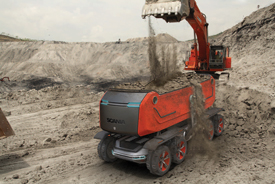|
Autonomous transport solutions open up a world of opportunities. Scania, a major Swedish automotive industry manufacturer of commercial vehicles, targets a complete system, handling logistics, the assignment of tasks to vehicles, and information sharing between vehicles and infrastructure. Each transport solution is individually tailored to the customer’s needs. During the first stage of development, Scania is focusing on industrial areas, such as mines, ports, or terminals.
 Industrial application was selected as the first business area because of its great economic potential, the possibility of operating selfdriving vehicles, and the relatively controlled environment. Still, it is in no way a trivial thing to operate heavy, self-driving machines anywhere. They need to be safe, but achieving this in an unpredictable environment such as a city center is much more difficult. The ability to start the automation journey in industrial areas puts commercial vehicle manufacturers like Scania in a unique position compared to other automotive companies as the business cases for passenger cars most often involve driving on public roads. Scania can start in the industrial sector and evolve from there to more complex environments while building experience and continuously releasing new commercial products throughout the journey.
There are, of course, still many challenges for the vehicles themselves in this kind of system. The self-driving vehicle must have a long chain of abilities, from using sensor data to see the environment, to understanding it and making the correct decisions, to controlling the vehicle. One of the advantages of self-driving industrial vehicles is safety; there are many environments in the mining industry that are dangerous or unhealthy to people. For example, work needs to cease during the ventilation of harmful gases after blasting. Autonomous vehicles can go to work immediately. In underground mining, many resources are spent on tunnel roof reinforcement before allowing people to enter. Self-driving vehicles do not have the same requirements.
Full article: IEEE Vehicular Technology Magazine, Volume 11, Number 3, September 2016 |